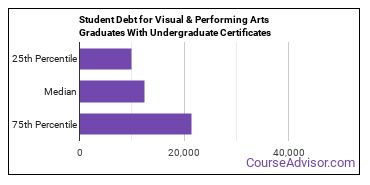Undergraduate Certificates in Visual & Performing Arts
Education Levels of Visual & Performing Arts Majors
During the most recent year for which data is available, 8,147 people earned their undergraduate certificate in visual & performing arts. The following table shows the number of diplomas awarded in visual & performing arts at each degree level.
| Education Level | Number of Grads |
|---|---|
| Bachelor’s Degree | 94,458 |
| Associate Degree | 19,205 |
| Master’s Degree | 16,688 |
| Basic Certificate | 8,443 |
| Undergraduate Certificate | 8,147 |
| Doctor’s Degree | 1,775 |
| Graduate Certificate | 1,060 |
Earnings of Visual & Performing Arts Majors With Undergraduate Certificates
The median salary for graduates holding an undergraduate certificate in visual & performing arts is $24,109. A lot of factors can contribute to this number, such as the location of your workplace and the availability of other perks and bonuses. To get a better picture, earnings for this category of people can range from a low of $16,262 to a high of $32,133.

Student Debt
The median student debt for graduates holding an undergraduate certificate in visual & performing arts is $31,301. The length of time it takes you to graduate and what college you attend can affect this number quite a bit. The chart below shows the range of accumulated debt loads. On the high side of the range, $43,282 is the debt load, and the debt load on the low side is $13,270.

The median monthly payment of a visual & performing arts graduate with a 10-year repayment plan is $373.
Student Diversity
More women than men pursue their undergraduate certificate in visual & performing arts. About 62.2% of graduates with this degree are female.
| Gender | Number of Grads |
|---|---|
| Men | 3,079 |
| Women | 5,068 |

The racial-ethnic distribution of visual & performing arts undergraduate certificate students is as follows:
| Race/Ethnicity | Number of Grads |
|---|---|
| Asian | 320 |
| Black or African American | 764 |
| Hispanic or Latino | 2,604 |
| White | 3,382 |
| International Students | 424 |
| Other Races/Ethnicities | 653 |

Explore Major by State
Alabama
Arkansas
Connecticut
Florida
Idaho
Iowa
Louisiana
Massachusetts
Mississippi
Nebraska
New Jersey
North Carolina
Oklahoma
Rhode Island
Tennessee
Vermont
West Virginia
References
*The racial-ethnic minority student count is calculated by taking the total number of students and subtracting white students, international students, and students whose race/ethnicity was unknown. This number is then divided by the total number of students at the school to obtain the percentage of racial-ethnic minorities.
- College Factual
- National Center for Education Statistics
- O*NET Online
- Bureau of Labor Statistics
- Image Credit: By Bonnielou2013 under License
More about our data sources and methodologies.
